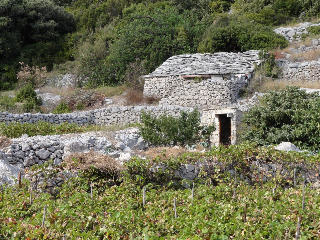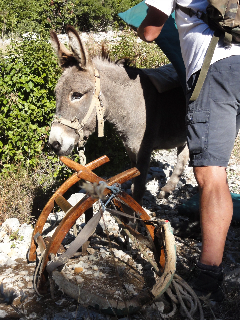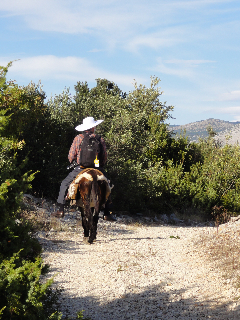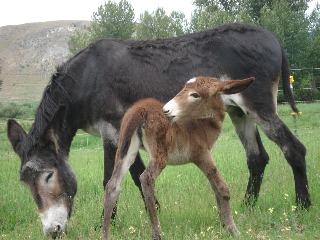home | internet service | web design | business directory | bulletin board | advertise | events calendar | contact | weather | cams

|
Time Travel with Bill Hottell or . . . Dear Methow Gardeners,  Terraces, stone huts and grapes under cultivation. Terraces, stone huts and grapes under cultivation.Last month I enjoyed the Bill Hottell trip to Croatia and Venice. Everyone had a favorite moment but the highlight for me was the donkey safari on the Island of Korcula. It gave us a mini-tour of Croatian agriculture and history. Bill was heard to repeatedly and deliriously exclaim, "We are traveling back 2,000 years!" And so it seemed. James, our host, graciously explained the current status of the Croatian donkey, the ancient stone olive and grape terraces, and the traditional connection between the villagers and the Adriatic bays of the island. Here is some of what I learned from James and a few books back home - Croatian Donkeys The Dalmatian or Dinaric donkey is a small grey beast. Our reluctant Belle was a Dalmatian donkey. The Istrian donkey (Istria, in northern Croatia, has soil, rain and trees v. sun, stones and slopes in southern Croatia) is medium-sized and black. Andrea was an Istrian donkey and he was willing. "Willing" in donkey-speak means eager to go. The two breeds are separate haplotypes reflecting a separate genetic path from an Africa wild ass, maybe mostly - or all - through the probably extinct Nubian donkey. Some think the physical route went from Africa/Middle East to the Mediterranean through Crete. The donkey was energy. The donkey provided land-based transport for much of the last 6,000 years. The donkey carried drinking water, fish, grapes, olives, tools, riders, basically everything. Without a donkey all a person had was their own back, or that of their wife and children or, if you were prosperous, a slave. With a donkey you could travel anywhere there was a tight opening in the vegetation and a bit of ground to stand on.  Belle, the Dalmation donkey, and her pack saddle. Belle, the Dalmation donkey, and her pack saddle.The donkey was also food energy. People ate donkeys then and in some places still do - just another way sunshine becomes plants and then becomes meat. Remember, "All flesh is grass." Isaiah 40:6 and 1 Peter 1:24 Our host learned the love of the humble donkey from his grandmother. He had to search for his ten animals and he has the only donkeys on the island. His newest struggle is to escape an onerous head tax on his animals from the European Union. James restored his beautiful old traditional pack saddles by soaking them for days in the sun in a vat of his family olive oil. The curved wood frames were made from small native trees naturally bent as the gentle curve of a donkey back. The donkeys enjoyed luscious spotless pads under their pack saddles. We each enjoyed the wood frame directly on our own ass. Needless to say, we walked much of the safari. The Safari Adventure We traveled from our guide's upland village to the top of the island on cobble paths between terraces, on top of terraces between wide stone walls filled with cobble, through the mache (shrub-steppe) on skinny trails and a few narrow roads shared with a couple old jalopies and then straight back down to the sea.  Bill Hottell on Andrea, the Istrian donkey. Bill Hottell on Andrea, the Istrian donkey.James explained the terraces were designed to slow the passage of water downslope. They were ancient and no one knew who had originally built them. The terraces fit the contour of the land. I assume the farmer planted what would do best on a particular slope, contour and exposure. The soil inside the walls seemed barely better than the walls themselves. Virtually none of the terraces were maintained. The grapes had not survived but a number of ancient olive trees are surviving. At home, his donkeys are tethered in a fresh terrace everyday and they eat it down. So the donkeys return good for good - clearing competitive vegetation from olives and returning the nutrients in their poop. Sustainable. James was injured in the 1991 war. He spent much of his life living and working outside the country and had an expatriate's respect for the traditional culture of his homeland. So not only was he preserving the last island herd, he was restoring his family trees, vines and the bayside/terrace stone hut. Historically, people would live most of the year in the village but move out into the terraces to care for the trees and vines and down to the bays for their fish. Stone huts set in the terraces sheltered people and their stock. We ate at the family bayside place. His uncle fished for us the day before we arrived. So we ate his oil, his wine, his liquor, his fish and eels, drank his cistern rainwater and were welcomed into his beautifully restored stone hut. Priceless. The Olives and Grapes People need about 30% of their calories in oil. Omega 3s, fat soluble vitamins and sterols. Southern Europe could raise oilseed crops. Northern Europe and Methow Valley natives must get their oil from animals and fish as the climate is too cold to grow oilseed crops. Palestine and Syria were home to the first cultivation of olive oil, then maybe Crete. Olive oil provided food, fuel, medicine, cosmetics, and a wood finish, as in the donkey saddle. Olive trees are slow to produce but live virtually forever. The best oil is from olives handpicked at the individual fruit's peak of ripening with the first pressing done cold and not refined. When unrefined, olive oil is remarkably stable. We just don't get this quality unless from a boutique presser. Grape cultivation probably came from the Caucasus Mountains and traveled two routes - Assyria, Babylon then Egypt or the Aegean to Crete onwards. War's disruptions are devastating to grape cultivation. (If you want to destroy the enemies' olive supply you have to actually cut down the trees, as done in Palestine today.) The role of wine in Christian liturgy and its cultivation by the monasteries helped preserve the grape and its quality varieties through the millennia. Again, there is a divergence because of climate - Southern Europe drank of the grape while Northern Europe drank beer or mead. Finally, we should remember that after the donkey hauled the olive and grape in he provided most of the muscle energy to press the olive and the grape. (In the parts of the Mediterranean that grow wheat the littlest donkey can fit inside the little huts to turn the mill stone by walking in endless circles. He is ignominiously called a "domestic grinder".The three - donkey, grape and olive are a set.  Mamma and Esther Mae, Jane’s Methow Mammoth donkeys, Mamma and Esther Mae, Jane’s Methow Mammoth donkeys,In Conclusion So what does any of this tell us about gardening in the Methow? We have Mediterranean summers but Northern European winters so I don't know. We have to find our own agricultural path forward. So again, maybe we just have to remember to be thankful for the rich diversity of nutritious and delicious food at the Red Apple, Glover Street, Hanks and from our farmer growers. We can eat and drink and be merry despite our challenging climate. Happy Thanksgiving and thanks for reading, 11/22/2011 read more of Jane Gilbertsen in the archive |